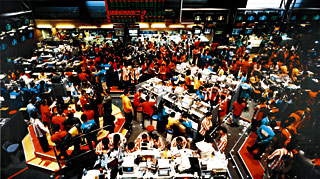|
 |
 |


|

Singapore Stock Exchange, 1997. Cibachrome print, mounted to Plexiglas, Plexiglas: 64 7/8 x 104 1/4 inches; image: 52 x 92 3/4 inches. Edition 6/6. Solomon R. Guggenheim Museum, Purchased with funds contributed by the Photography Committee. 98.4627 |
 |
 |
Andreas Gursky's photographic vision is extraordinarily precise. Teasing an eccentric geometry out of each of his subjects, Gursky reorders the world according to his own visual logic, accumulating myriad details to offer a sense of harmonic coherence. The artist's subject matter is late capitalist society and the systems of exchange which organize it. His pictures may be described as modern-day versions of classical history painting in that they reproduce the collective mythologies that fuel contemporary culture: travel and leisure (sporting events, clubs, airports, hotel interiors, art galleries), finance (stock exchanges, sites of commerce), material production (factories, production lines), and information (libraries, book pages, data). Yet despite the traditions he invokes both formally and conceptually, Gursky has no pretense to objectivity. He digitally manipulates his images—combining discrete views of the same subject, deleting extraneous details, enhancing colors—to create a kind of "assisted realism" as in Library (1999). This view of the Stockholm public library, a perfect hemisphere of color-coded books, omits the actual floor, which, in reality, includes an escalator that would have marred the symmetry of the image. Likewise, the traders in Gursky's rendering of the Singapore stock exchange wear only red, yellow, or blue jackets.
|
|















